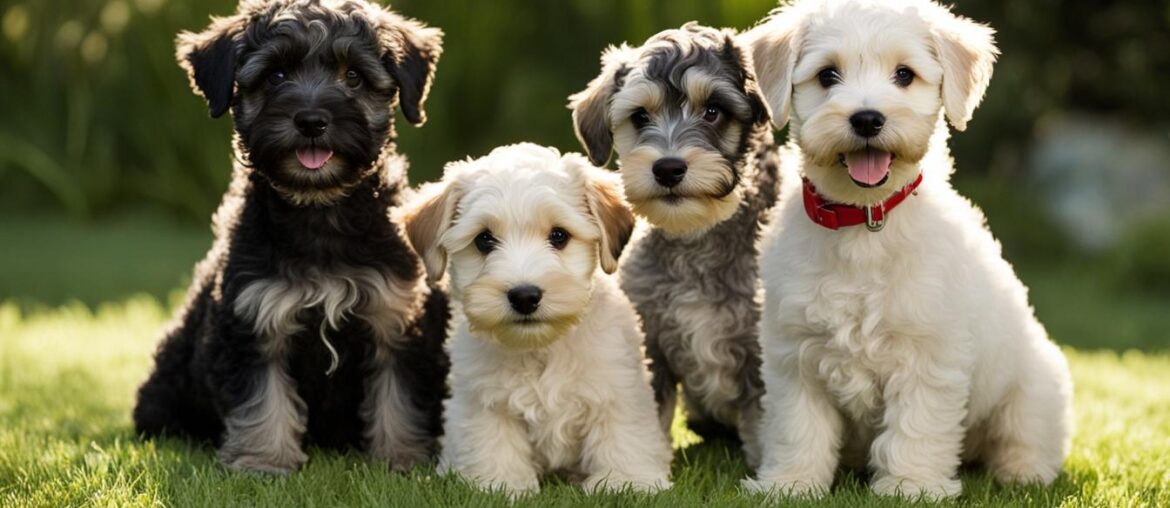Welcome to my article on Schnoodle dog breeds! If you’re looking for a lovable and intelligent companion, Schnoodles might just be the perfect addition to your family. These designer dogs are a cross between a Poodle and a Schnauzer, resulting in a delightful mix of traits that make them highly sought-after pets.
Schnoodles come in various sizes, from toy to giant, and boast a curly, low-shedding coat. They are known for their intelligence, loyalty, and playful nature, making them ideal family dogs. In fact, they are often considered hypoallergenic, making them a great choice for individuals with allergies.
To ensure the well-being of your Schnoodle, regular grooming and exercise are crucial. Additionally, understanding their size and temperament will help you provide the best possible care. Read on to learn more about the different sizes, temperament, health, care needs, and more!
Key Takeaways:
- Schnoodles are a popular designer dog breed, known for their intelligence and playful nature.
- They come in various sizes, from toy to giant, and have a curly, low-shedding coat.
- Schnoodles are often considered hypoallergenic, making them suitable for individuals with allergies.
- Regular grooming and exercise are essential for keeping Schnoodles healthy and happy.
- They make great family pets and are known for their loyalty and compatibility with children and other pets.
The Different Sizes of Schnoodles

Schnoodles come in four different sizes: toy, miniature, standard, and giant. The size of a Schnoodle is determined by the size of its parent breeds.
A Toy Schnoodle weighs between 5 and 15 pounds, making it the smallest size. They are compact and perfect for those looking for a small companion dog.
A Miniature Schnoodle weighs between 15 and 30 pounds, offering a slightly larger option without being too big. They are great for families or individuals who want a medium-sized dog.
A Standard Schnoodle is larger, weighing between 30 and 50 pounds. They are more suitable for families with larger living spaces and can be quite active and playful.
The Giant Schnoodle is the largest size, weighing around 50 to 70 pounds. They are sturdy dogs, ideal for families or individuals who prefer larger breeds.
The most common cross for Schnoodles is between a Miniature Schnauzer and a Toy or Miniature Poodle, which contributes to their various sizes.
| Schnoodle Size | Weight Range (pounds) |
|---|---|
| Toy Schnoodle | 5-15 |
| Miniature Schnoodle | 15-30 |
| Standard Schnoodle | 30-50 |
| Giant Schnoodle | 50-70 |
Image related to the Different Sizes of Schnoodles:
The Temperament of Schnoodles
Schnoodles are known for their friendly, intelligent, and playful temperament. These lovable dogs are a joy to have as family pets.
One of the defining characteristics of Schnoodles is their friendliness. They are naturally sociable and enjoy being around people and other animals. Schnoodles are particularly good with children, making them ideal companions for families. Their playful nature and gentle disposition make them a great choice for households with young kids.
Intelligence is another standout trait of Schnoodles. They are quick learners and love mental challenges. Whether it’s learning new tricks or solving puzzles, Schnoodles thrive on mental stimulation. This intelligence also contributes to their trainability. They respond well to positive reinforcement training methods and are eager to please their owners.
Schnoodles are not only friendly and intelligent but also incredibly loyal. They form strong bonds with their families and thrive on attention and affection. They are always ready to shower their loved ones with love and companionship.
However, it is important to note that Schnoodles can be prone to excessive barking if not trained early on. This behavior can be curbed through consistent training and positive reinforcement. Early socialization is also essential to ensure they develop good habits and manners.
Schnoodles are known for their friendly, intelligent, and playful temperament. They are loyal dogs that are good with children and other pets. They are easy to train and love to learn new tricks.
The affectionate nature of Schnoodles makes them true family dogs. They enjoy nothing more than being by their owners’ side, whether it’s cuddling on the couch or going for long walks.
Overall, the temperament of Schnoodles can be described as friendly, intelligent, playful, and loyal. They are the perfect companions for those looking for a loving and devoted friend.
| Temperament Traits | Description |
|---|---|
| Friendly | Schnoodles are naturally sociable and get along well with people and other animals. |
| Intelligent | These dogs are quick learners and enjoy mental challenges. |
| Playful | Schnoodles love to play and engage in interactive activities. |
| Loyal | They form strong bonds with their families and are fiercely loyal. |
Schnoodle Health and Care
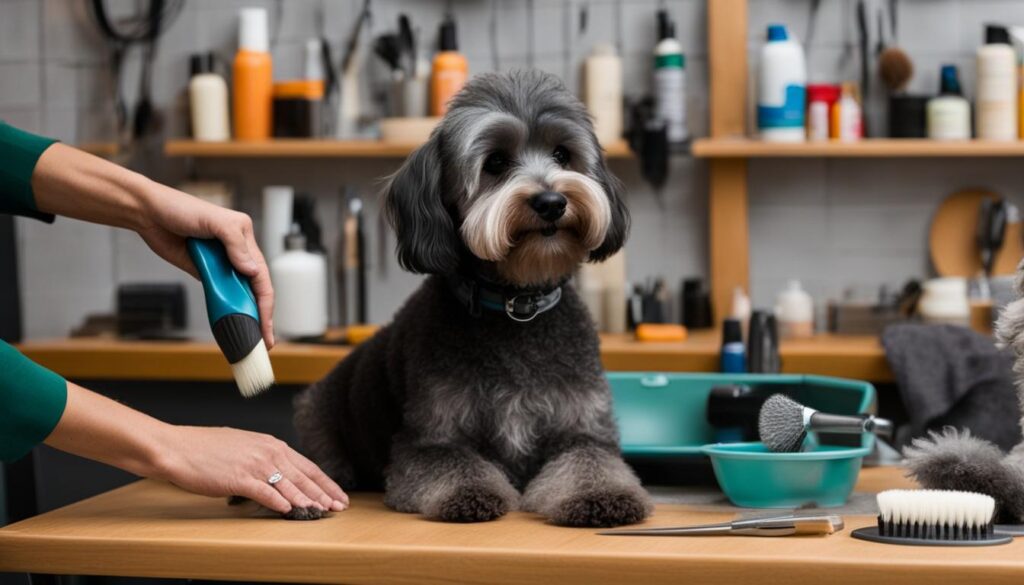
Schnoodles are generally a healthy breed, but it’s important to be aware of potential health problems that they may be prone to. Taking proper care of your Schnoodle’s health is essential to ensure they live a happy and fulfilling life.
Common Schnoodle Health Problems
While Schnoodles are generally a healthy breed, they can be prone to certain health conditions, which are also seen in their parent breeds, Poodles and Schnauzers. Some of the common health problems that Schnoodles may develop include:
- Cataracts: Schnoodles can develop cataracts, which is a clouding of the lens of the eye. Poodles are particularly prone to this condition, and it can occur in Schnoodles as well.
- Addison’s Disease: This is a condition where the adrenal glands do not produce enough hormones. It can affect both Poodles and Schnauzers, and Schnoodles may be at a higher risk.
- Epilepsy: Epilepsy is a neurological condition that can cause seizures. Poodles and Schnauzers are both prone to epilepsy, and Schnoodles may also be affected.
- Diabetes Mellitus: This is a chronic condition where the body is unable to regulate blood sugar levels properly. Both Poodles and Schnauzers can develop diabetes, and Schnoodles may be predisposed as well.
It’s important to monitor your Schnoodle’s health and be vigilant for any signs or symptoms of these conditions. Regular visits to a veterinarian and routine check-ups can help detect any health issues early on, improving the chances for successful treatment.
Grooming and Coat Maintenance
Grooming is an essential part of Schnoodle care, particularly due to their curly coats. Regular grooming helps keep their coats healthy, prevents matting, and keeps them looking their best. Here are some grooming tips for Schnoodles:
- Brush your Schnoodle’s coat at least once a week to prevent matting and remove loose hair.
- Consider taking your Schnoodle to a professional groomer every 6-8 weeks for a trim and full grooming session.
- Clean your Schnoodle’s ears regularly to prevent infections.
- Trim your Schnoodle’s nails regularly to prevent overgrowth and discomfort.
Regular grooming not only keeps your Schnoodle looking great, but it also helps maintain their overall health and hygiene.
Health Conditions in Schnoodles
| Health Condition | Prevalence | Symptoms | Treatment |
|---|---|---|---|
| Cataracts | Common | Cloudiness or opacity in the lens of the eye | Surgery to remove the cataracts |
| Addison’s Disease | Occasional | Decreased appetite, lethargy, vomiting, weight loss | Hormone replacement therapy |
| Epilepsy | Occasional | Recurrent seizures, loss of consciousness | Anti-seizure medication |
| Diabetes Mellitus | Occasional | Increased thirst and urination, weight loss, lethargy | Insulin therapy, dietary management |
Exercise and Training for Schnoodles
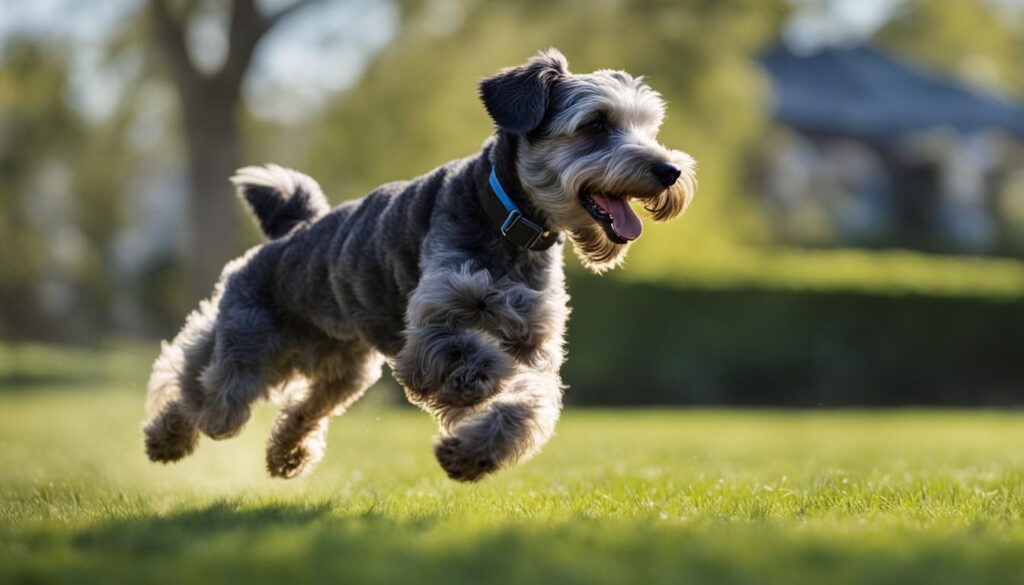
Schnoodles have moderate exercise needs and benefit from at least 30 minutes of daily physical activity. Regular exercise is essential for maintaining their overall health and well-being. Engaging in various activities not only helps them burn off excess energy but also keeps their minds stimulated. Here are some exercise ideas that can keep your Schnoodle happy:
- Playing fetch: Schnoodles love to chase and retrieve objects. A game of fetch in the backyard or a local park can be a great way to exercise them.
- Going for walks: Schnoodles enjoy exploring their surroundings and going for walks with their owners. Regular walks not only provide exercise but also mental stimulation as they get to sniff new scents and interact with the environment.
- Running: Schnoodles have a playful nature and love to run. If you have a fenced yard, let them run freely, or take them for a jog if you’re an avid runner.
In addition to physical exercise, mental stimulation is vital for Schnoodles. They are intelligent dogs that thrive on mental challenges. Incorporating mental stimulation into their daily routine can prevent boredom and provide a sense of fulfillment. Here are some ideas for mental enrichment:
- Training sessions: Schnoodles are highly trainable and respond well to positive reinforcement methods. Use treats and praise to reward them when they learn new commands or tricks.
- Puzzle toys: Interactive puzzle toys can keep your Schnoodle mentally engaged and entertained. These toys often involve problem-solving tasks that require them to figure out how to access hidden treats or toys.
- Hide-and-seek: Hide treats or toys in different areas of your home and encourage your Schnoodle to find them. This game stimulates their sense of smell and engages their problem-solving skills.
Remember to always prioritize positive reinforcement when training your Schnoodle. Use praise, treats, and affection to reward good behavior, as it helps foster a strong bond between you and your furry friend.
Choosing a Schnoodle as a Family Pet

Schnoodles make excellent family pets as they are known to be good with children and other pets. They are friendly and playful, making them great companions for kids. However, early socialization is important to ensure they get along well with other animals and strangers. Schnoodles are also known to be good with other dogs and cats if they have been properly socialized.
The Benefits of Schnoodles as Family Pets
- Good with children: Schnoodles have a gentle and patient nature, making them ideal companions for children. They are playful and energetic, and they enjoy participating in various activities with kids.
- Good with other pets: Schnoodles have a friendly and sociable temperament, which allows them to get along well with other pets, such as dogs and cats. With proper socialization and introductions, they can easily form positive relationships with their furry friends.
- Friendly and playful: Schnoodles are known for their cheerful and outgoing personalities. They love to interact and play with their human family members, making them a joy to have around.
When introducing a Schnoodle to a family with children or other pets, it is important to supervise the interactions at first and ensure that everyone is comfortable and safe. Early socialization and training are crucial to help the Schnoodle develop good manners and adapt well to different environments.
“Schnoodles are gentle, patient, and playful, making them great companions for children and other pets.” – Dr. Emily Thompson, Veterinarian
The Importance of Early Socialization
Early socialization plays a crucial role in shaping the behavior and temperament of a Schnoodle. By exposing them to various people, animals, sounds, and environments from a young age, you can help them become well-rounded and confident individuals.
Here are some tips for socializing your Schnoodle:
- Introduce your Schnoodle to different people, including men, women, children, and individuals wearing different clothing (e.g., hats, sunglasses).
- Expose your Schnoodle to different environments, such as parks, beaches, and busy streets, to help them become comfortable in various situations.
- Arrange controlled and supervised playdates with other well-behaved dogs and cats to encourage positive interactions.
- Expose your Schnoodle to different sounds, such as vacuum cleaners, doorbells, and sirens, to help them become familiar with common noises.
By following these socialization techniques, you can help your Schnoodle become a well-adjusted and sociable pet that gets along with everyone in your family.
| Benefits of Choosing a Schnoodle as a Family Pet | Considerations for Choosing a Schnoodle as a Family Pet |
|---|---|
|
|
Schnoodle Size and Living Arrangements
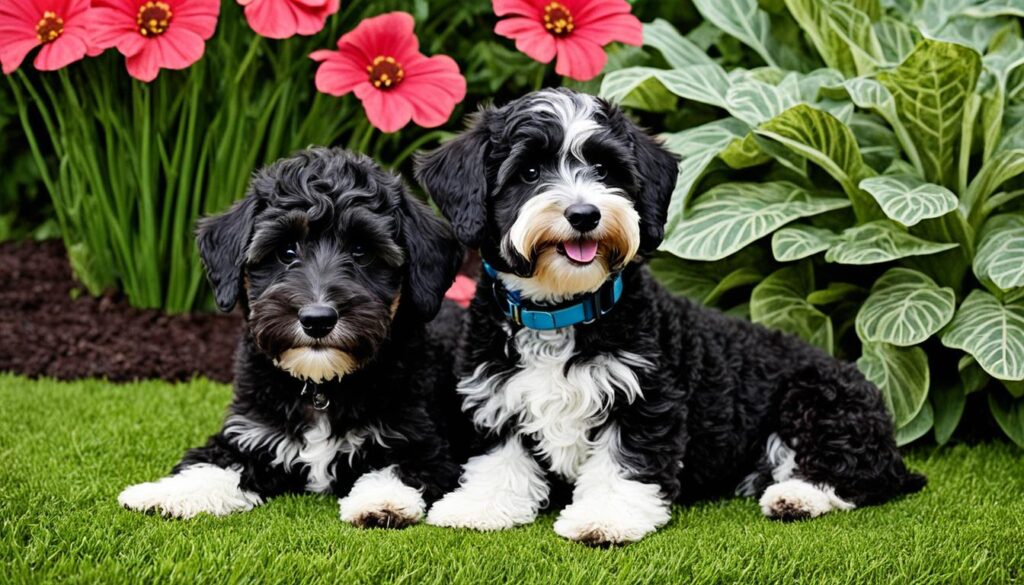
The size of a Schnoodle will determine the living arrangements that are best for them. Smaller Schnoodles, such as Toy or Miniature, can adapt well to apartment living as long as they receive regular exercise. They make great lap dogs and enjoy being with their families. Larger Schnoodles, such as Standard or Giant, will need a fenced yard to play in and will do better in a house with more space.
Apartment-Friendly Schnoodles
Apartment living can be suitable for smaller Schnoodles, particularly Toy or Miniature sizes. Despite their small stature, these Schnoodles still require regular exercise to stay happy and healthy. Taking them for walks, engaging in indoor playtime, and providing mentally stimulating activities will help meet their exercise needs. Schnoodles thrive when they are close to their families and enjoy being lap dogs. Their adaptable nature makes them well-suited for apartment living.
Need for a Fenced Yard
On the other hand, larger Schnoodles like Standard or Giant sizes have higher energy levels and need more space to roam and play. Having a fenced yard allows them to safely explore and exercise without the constraints of an apartment. It’s important to note that Schnoodles are a mix of Schnauzers and Poodles, both of which have a tendency to be exploratory. A fenced yard provides them with the opportunity to indulge in their curiosity and burn off excess energy. This helps prevent behavioral issues that may arise from pent-up energy.
Table: Schnoodle Size Comparison and Living Arrangements
| Schnoodle Size | Living Arrangements |
|---|---|
| Toy Schnoodle | Apartment living with regular exercise |
| Miniature Schnoodle | Apartment living with regular exercise |
| Standard Schnoodle | House with a fenced yard for ample exercise |
| Giant Schnoodle | House with a fenced yard for ample exercise |
Grooming and Care for Schnoodles
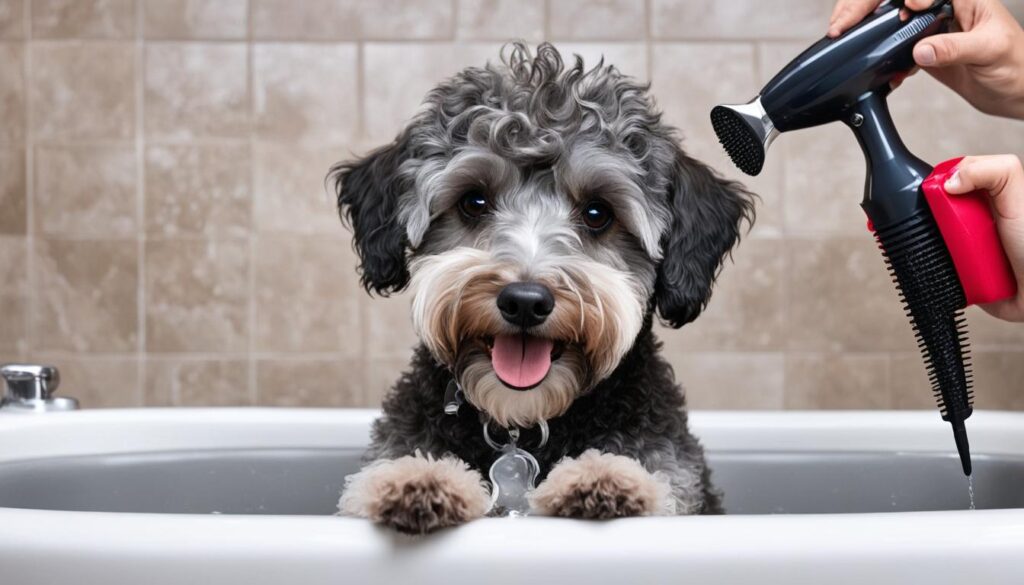
Schnoodles require regular grooming to keep their curly coats in good condition. Proper grooming not only keeps them looking their best but also ensures their overall health and well-being. Here are some essential grooming and care tips for Schnoodles:
Regular Brushing
Regular brushing is crucial for Schnoodles to prevent mats and tangles in their curly coats. It is recommended to brush your Schnoodle at least once a week using a slicker brush or a comb with wide teeth. This helps remove loose hair, prevent matting, and keeps their coat looking clean and tidy.
Professional Grooming
While regular brushing is important, Schnoodles also need professional grooming every few months. A professional groomer has the expertise to properly trim their coat, giving them a neat and well-maintained appearance. Professional grooming includes a haircut, nail trimming, ear cleaning, and ensuring their overall hygiene.
Coat Maintenance
In addition to regular brushing and professional grooming, Schnoodles’ coats require specific maintenance. This includes keeping their coat clean and free from dirt and debris. Regular bathing with a mild dog shampoo is necessary but be cautious not to overdo it as it can strip their coat of natural oils. It’s also important to regularly check and clean their ears to prevent infections.
| Grooming Task | Frequency |
|---|---|
| Brushing | At least once a week |
| Professional Grooming | Every few months |
| Bathing | When necessary, using a mild dog shampoo |
| Nail Trimming | Every 4-6 weeks |
| Ear Cleaning | Weekly |
Grooming and care play a vital role in keeping Schnoodles healthy, comfortable, and looking their best. By following proper grooming practices and maintaining their coat, you can ensure your Schnoodle stays happy and thriving.
Wrapping Up
Schnoodles are a popular and lovable designer dog breed that combines the best traits of Poodles and Schnauzers. They are intelligent, friendly, and adaptable, making them great family pets.
With regular grooming and exercise, Schnoodles can thrive in a variety of living arrangements and bring joy to their families. Their hypoallergenic coat makes them an ideal choice for those with allergies. Schnoodles are highly trainable and love to learn new tricks, making them a joy to have around.
If you’re looking for a smart and affectionate dog that will blend well with your family, the Schnoodle may be the perfect choice for you. Consider adding this wonderful breed to your home and experience the love and companionship that a Schnoodle can bring.
FAQ
What is a Schnoodle?
A Schnoodle is a popular designer dog breed that is a cross between a Poodle and a Schnauzer.
What are the different sizes of Schnoodles?
Schnoodles come in four different sizes: Toy, Miniature, Standard, and Giant.
What is the temperament of Schnoodles?
Schnoodles are known for their friendly, intelligent, and playful temperament.
What are the common health problems of Schnoodles?
Schnoodles can be prone to cataracts, Addison’s disease, epilepsy, and diabetes mellitus.
How much exercise do Schnoodles need?
Schnoodles should have at least 30 minutes of exercise per day.
Are Schnoodles good family pets?
Yes, Schnoodles make excellent family pets and are good with children and other pets.
Can Schnoodles adapt to apartment living?
Smaller Schnoodles, such as Toy or Miniature, can adapt well to apartment living with regular exercise.
How should I groom and care for my Schnoodle?
Schnoodles require regular grooming, including brushing, professional grooming, ear cleaning, and nail trimming.


